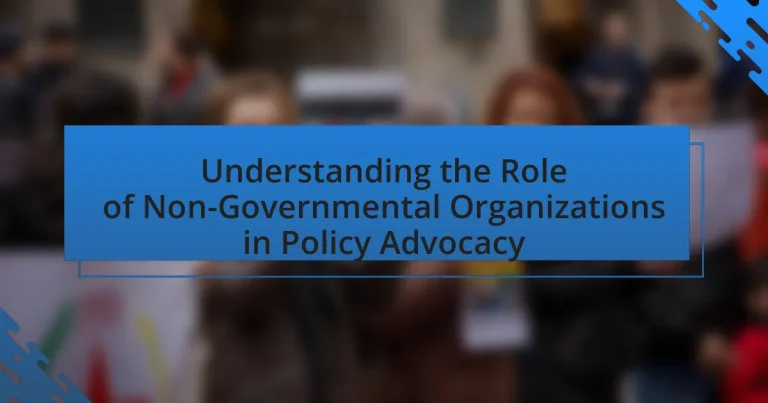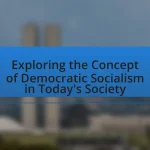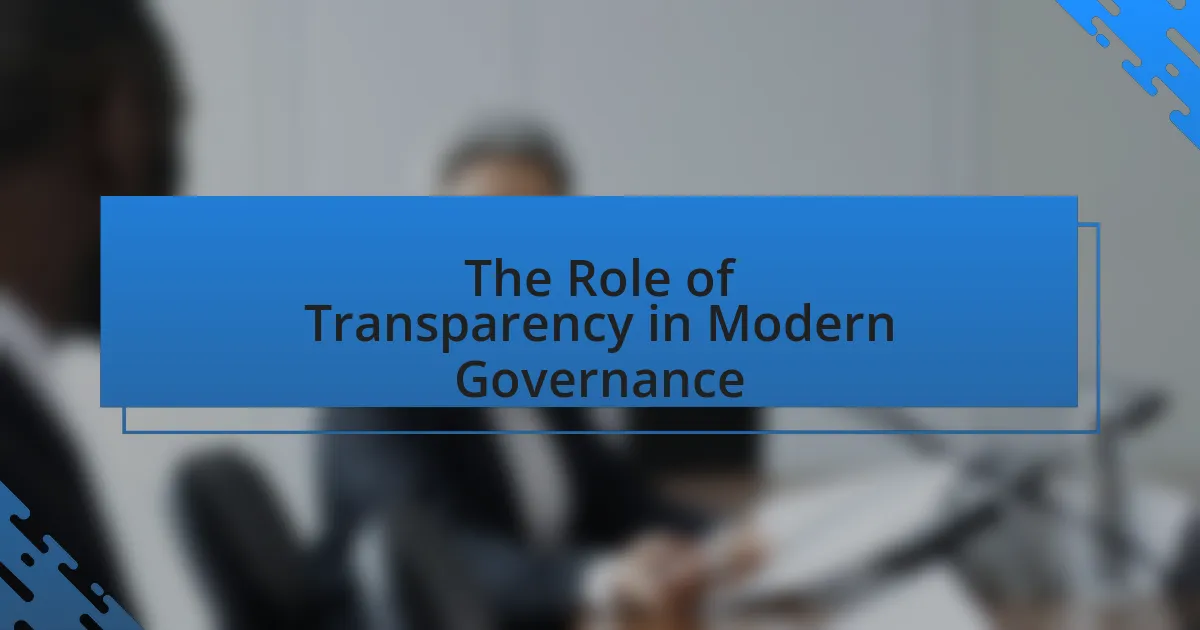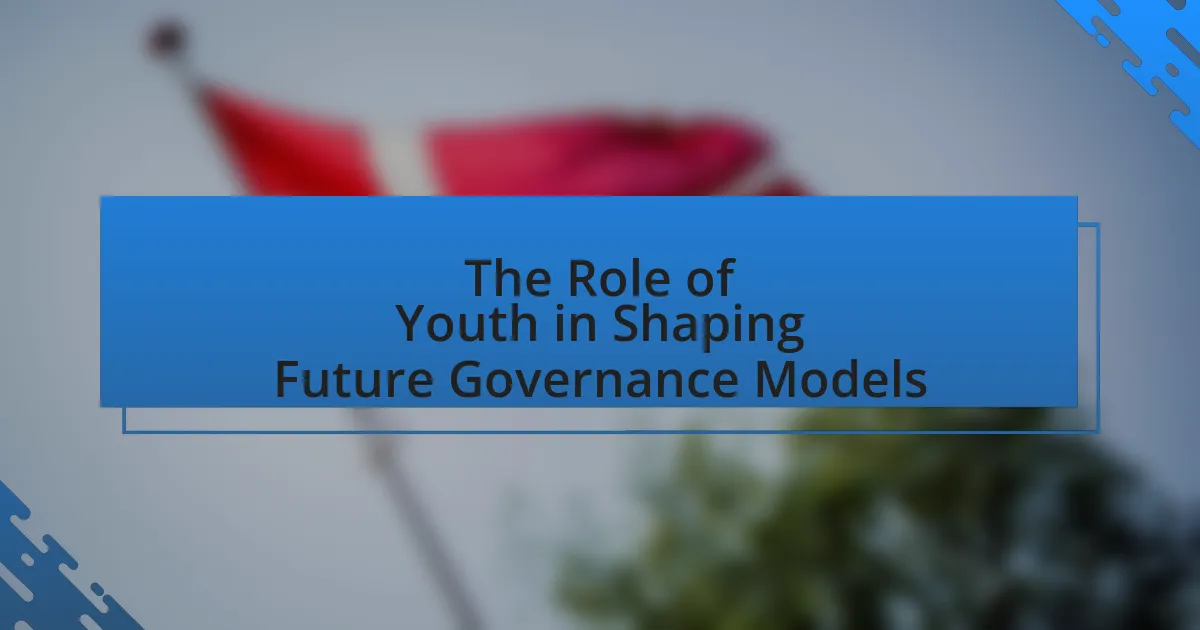Non-Governmental Organizations (NGOs) play a vital role in policy advocacy by influencing public policy and decision-making processes through research, awareness-raising, and mobilizing public opinion. The article explores how NGOs utilize various strategies, such as grassroots mobilization and coalition building, to impact policy decisions across different regions and sectors. It highlights the importance of NGOs in representing marginalized voices, enhancing public participation, and providing expert knowledge, while also addressing the challenges they face, including funding limitations and political resistance. Additionally, the article discusses best practices for effective advocacy, the significance of collaboration, and the ethical considerations that guide NGO efforts in shaping policies.
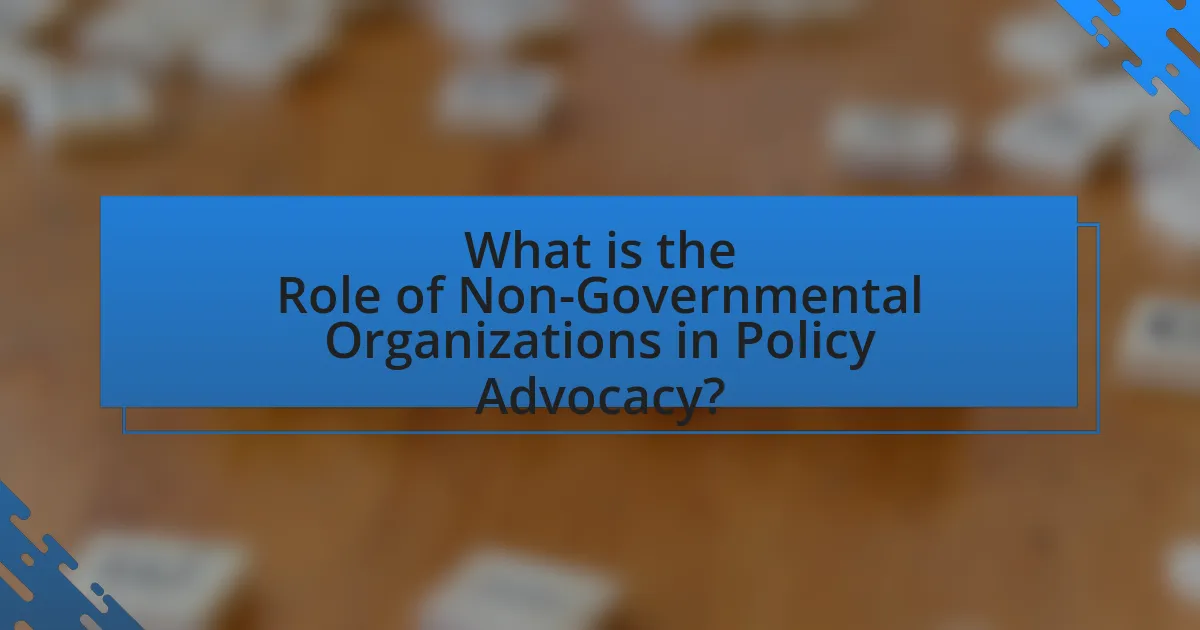
What is the Role of Non-Governmental Organizations in Policy Advocacy?
Non-Governmental Organizations (NGOs) play a crucial role in policy advocacy by influencing public policy and decision-making processes. They engage in research, raise awareness, and mobilize public opinion to address social, environmental, and economic issues. For instance, NGOs like Amnesty International and Greenpeace have successfully lobbied for changes in legislation related to human rights and environmental protection, respectively. Their efforts often include grassroots campaigns, partnerships with other organizations, and direct engagement with policymakers, which can lead to significant shifts in policy frameworks. This influence is supported by their ability to represent marginalized voices and provide expert knowledge on specific issues, thereby enhancing democratic processes and accountability in governance.
How do Non-Governmental Organizations influence policy decisions?
Non-Governmental Organizations (NGOs) influence policy decisions primarily through advocacy, lobbying, and public awareness campaigns. By mobilizing public opinion and leveraging their expertise, NGOs can shape the agenda and priorities of policymakers. For instance, organizations like Amnesty International and Greenpeace have successfully pressured governments to adopt more stringent environmental regulations and human rights protections by presenting research, organizing protests, and engaging in direct dialogue with lawmakers. Their ability to gather data, conduct studies, and disseminate information enhances their credibility and effectiveness in influencing legislative outcomes.
What strategies do Non-Governmental Organizations use in advocacy?
Non-Governmental Organizations (NGOs) employ various strategies in advocacy, including grassroots mobilization, coalition building, policy research, and public awareness campaigns. Grassroots mobilization involves engaging community members to participate in advocacy efforts, which can amplify their voices and influence policymakers. Coalition building allows NGOs to unite with other organizations to strengthen their collective impact and share resources. Policy research provides evidence-based data that supports their advocacy positions, making their arguments more compelling. Public awareness campaigns utilize media and communication strategies to inform and educate the public about specific issues, thereby generating broader support for their causes. These strategies are essential for NGOs to effectively influence policy and drive social change.
How do these strategies vary across different regions?
Strategies employed by non-governmental organizations (NGOs) in policy advocacy vary significantly across different regions due to cultural, political, and economic contexts. For instance, in North America, NGOs often leverage strong legal frameworks and public engagement to influence policy, while in regions with authoritarian regimes, such as parts of the Middle East, NGOs may focus on grassroots mobilization and covert operations to advocate for change. Additionally, in Europe, NGOs frequently collaborate with governmental bodies and utilize EU regulations to shape policy, whereas in Africa, NGOs might prioritize community-based approaches to address local issues, reflecting the diverse socio-political landscapes. These variations are supported by the differing levels of governmental openness, civil society engagement, and resource availability across regions.
Why are Non-Governmental Organizations important in the policy-making process?
Non-Governmental Organizations (NGOs) are important in the policy-making process because they provide expertise, represent marginalized voices, and advocate for social change. NGOs often possess specialized knowledge and research capabilities that inform policymakers about critical issues, such as environmental protection or human rights. For instance, organizations like Amnesty International have influenced legislation by highlighting human rights abuses, leading to policy reforms in various countries. Additionally, NGOs serve as a bridge between the public and government, ensuring that the concerns of underrepresented communities are addressed in policy discussions. Their ability to mobilize public opinion and engage in advocacy campaigns further amplifies their impact on shaping policies that reflect societal needs.
What unique perspectives do Non-Governmental Organizations bring to policy discussions?
Non-Governmental Organizations (NGOs) bring diverse perspectives to policy discussions by representing marginalized voices and advocating for social justice. They often highlight issues that may be overlooked by governmental bodies, such as human rights, environmental concerns, and community needs. For instance, NGOs like Amnesty International focus on human rights violations, providing data and testimonies that inform policy debates. Additionally, NGOs contribute expertise and research that can shape evidence-based policies, as seen in the work of organizations like the World Wildlife Fund, which influences environmental legislation through scientific studies. Their grassroots connections enable them to mobilize public opinion and foster community engagement, making them vital players in the policy-making process.
How do Non-Governmental Organizations enhance public participation in policy advocacy?
Non-Governmental Organizations (NGOs) enhance public participation in policy advocacy by facilitating community engagement, providing education, and mobilizing grassroots movements. NGOs often organize workshops, forums, and campaigns that inform the public about policy issues, thereby increasing awareness and understanding. For instance, a study by the World Bank found that NGOs significantly improve civic engagement by creating platforms for dialogue between citizens and policymakers. Additionally, NGOs leverage social media and technology to reach broader audiences, encouraging public discourse and participation in advocacy efforts. This multifaceted approach not only empowers individuals but also amplifies their voices in the policymaking process.
What challenges do Non-Governmental Organizations face in policy advocacy?
Non-Governmental Organizations (NGOs) face several challenges in policy advocacy, including limited funding, political resistance, and lack of access to decision-makers. Limited funding restricts their ability to conduct research, mobilize resources, and sustain long-term advocacy efforts, as evidenced by a 2020 report from the Global Fund for Community Foundations, which highlighted that 70% of NGOs reported funding constraints as a significant barrier. Political resistance often manifests in the form of government pushback against NGO initiatives, particularly in authoritarian regimes, where NGOs may be viewed as threats to state power. Additionally, lack of access to decision-makers can hinder NGOs’ ability to influence policy, as many policymakers may prioritize the interests of larger, more established entities over smaller NGOs. These challenges collectively impede the effectiveness of NGOs in shaping public policy.
How do funding limitations impact the effectiveness of Non-Governmental Organizations?
Funding limitations significantly reduce the effectiveness of Non-Governmental Organizations (NGOs) by constraining their operational capacity and limiting program implementation. When NGOs face financial constraints, they often struggle to maintain staff, which can lead to decreased expertise and reduced outreach efforts. For instance, a study by the World Bank found that NGOs with stable funding are 50% more likely to achieve their project goals compared to those with fluctuating or insufficient funding. Additionally, limited resources can hinder NGOs’ ability to conduct research, advocate for policy changes, and engage with stakeholders effectively, ultimately diminishing their impact on social issues.
What role does political climate play in the advocacy efforts of Non-Governmental Organizations?
The political climate significantly influences the advocacy efforts of Non-Governmental Organizations (NGOs) by shaping the regulatory environment, public perception, and funding opportunities. A supportive political climate can enhance NGOs’ ability to mobilize resources, engage stakeholders, and influence policy decisions, as seen in countries with democratic governance where civil society is encouraged. Conversely, in authoritarian regimes or politically unstable regions, NGOs often face restrictions, censorship, and limited access to funding, which hampers their advocacy efforts. For instance, according to the 2021 CIVICUS Monitor, countries like Hungary and Turkey have seen a decline in civic space, directly impacting NGOs’ capacity to advocate for human rights and social justice. Thus, the political climate acts as a critical determinant of the effectiveness and reach of NGO advocacy initiatives.
How do Non-Governmental Organizations collaborate with other stakeholders?
Non-Governmental Organizations (NGOs) collaborate with other stakeholders through partnerships, coalitions, and networks to enhance their advocacy efforts. These collaborations often involve sharing resources, expertise, and information to address common goals, such as influencing policy changes or improving community welfare. For instance, NGOs frequently partner with governmental agencies, private sector entities, and community organizations to leverage diverse perspectives and capabilities, which can lead to more effective solutions. A notable example is the collaboration between NGOs and the United Nations, where NGOs contribute to policy discussions and implementation strategies, thereby amplifying their impact on global issues like climate change and human rights.
What partnerships are most effective for Non-Governmental Organizations in advocacy?
Collaborative partnerships with grassroots organizations, academic institutions, and other NGOs are most effective for Non-Governmental Organizations (NGOs) in advocacy. These partnerships enhance resource sharing, amplify voices, and increase credibility. For instance, NGOs that collaborate with grassroots organizations can leverage local knowledge and networks, which is crucial for mobilizing community support and ensuring that advocacy efforts are grounded in the realities faced by affected populations. Academic partnerships provide access to research and data that can strengthen advocacy arguments, while alliances with other NGOs can create a united front, increasing the impact of campaigns. Evidence shows that coalitions, such as the Global Fund for Women, have successfully influenced policy changes by combining resources and expertise from multiple organizations, demonstrating the effectiveness of these partnerships in achieving advocacy goals.
How can Non-Governmental Organizations leverage coalitions for greater impact?
Non-Governmental Organizations (NGOs) can leverage coalitions for greater impact by collaborating with other organizations to amplify their advocacy efforts and share resources. By forming coalitions, NGOs can pool their expertise, increase their visibility, and enhance their bargaining power in policy discussions. For instance, the Global Fund to Fight AIDS, Tuberculosis and Malaria demonstrates how NGOs can unite to address global health issues effectively, resulting in significant funding and policy changes. This collaborative approach allows NGOs to tackle complex social problems more efficiently and influence decision-makers through a unified voice.
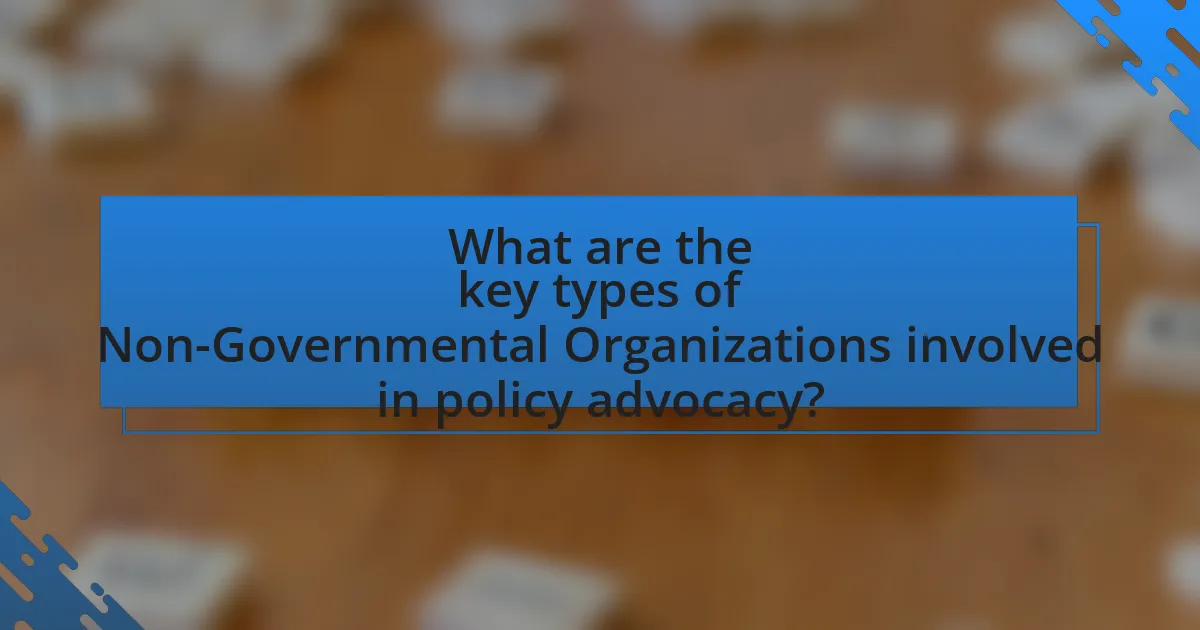
What are the key types of Non-Governmental Organizations involved in policy advocacy?
The key types of Non-Governmental Organizations (NGOs) involved in policy advocacy include advocacy NGOs, service NGOs, and grassroots organizations. Advocacy NGOs focus primarily on influencing public policy and decision-making processes, often through research, lobbying, and public campaigns. Service NGOs provide direct services to communities while also engaging in advocacy to address systemic issues affecting those communities. Grassroots organizations mobilize local communities to advocate for change, emphasizing community participation and empowerment. These types of NGOs play a crucial role in shaping policies by representing diverse interests and perspectives, thereby contributing to democratic processes and social change.
What distinguishes advocacy organizations from service organizations?
Advocacy organizations primarily focus on influencing public policy and social change, while service organizations concentrate on providing direct assistance and support to individuals or communities. Advocacy organizations engage in activities such as lobbying, public campaigns, and research to promote specific causes or issues, aiming to shape legislation and public opinion. In contrast, service organizations deliver tangible services, such as healthcare, education, or housing, directly to beneficiaries, addressing immediate needs rather than broader systemic change. This distinction is evident in the operational goals and methods employed by each type of organization, with advocacy organizations prioritizing policy influence and service organizations emphasizing direct service delivery.
How do advocacy organizations prioritize their goals and objectives?
Advocacy organizations prioritize their goals and objectives by conducting assessments of community needs, aligning with their mission, and evaluating the potential impact of their initiatives. These organizations often utilize data-driven approaches, such as surveys and stakeholder consultations, to identify pressing issues that resonate with their target audience. For instance, the American Civil Liberties Union (ACLU) prioritizes civil rights issues based on public demand and legal significance, ensuring that their efforts address the most urgent societal challenges. Additionally, they consider resource availability and strategic partnerships, which further influence their prioritization process. This systematic approach allows advocacy organizations to focus their efforts effectively and maximize their influence in policy advocacy.
What examples illustrate the work of advocacy organizations in specific sectors?
Advocacy organizations play crucial roles in various sectors by influencing policy and raising awareness. For example, the American Civil Liberties Union (ACLU) works in the civil rights sector, advocating for individual freedoms and challenging unconstitutional laws through litigation and public education. In the environmental sector, Greenpeace campaigns against climate change and deforestation, utilizing direct action and lobbying to promote sustainable practices. Additionally, the World Wildlife Fund (WWF) focuses on wildlife conservation and environmental sustainability, employing research and advocacy to influence global policies on biodiversity. These organizations exemplify how advocacy efforts can lead to significant changes in legislation and public awareness across different sectors.
How do grassroots organizations contribute to policy advocacy?
Grassroots organizations contribute to policy advocacy by mobilizing community members to influence decision-makers and raise awareness about specific issues. These organizations often engage in activities such as organizing campaigns, conducting research, and facilitating public discussions, which empower individuals to voice their concerns and advocate for change. For instance, the grassroots movement for climate action has successfully pressured governments to adopt more stringent environmental policies, demonstrating the effectiveness of collective action in shaping policy outcomes. Additionally, grassroots organizations often provide critical data and personal narratives that highlight the real-world impacts of policies, making their advocacy efforts more compelling to policymakers.
What methods do grassroots organizations use to mobilize communities?
Grassroots organizations mobilize communities primarily through community organizing, advocacy campaigns, and coalition building. Community organizing involves engaging local residents to identify shared concerns and develop collective strategies for action, often utilizing door-to-door outreach and public meetings to foster participation. Advocacy campaigns leverage social media, public demonstrations, and petitions to raise awareness and influence policy decisions, effectively amplifying community voices. Coalition building brings together diverse groups to strengthen efforts and resources, enhancing the impact of initiatives. These methods are supported by historical examples, such as the Civil Rights Movement, where grassroots mobilization played a crucial role in achieving legislative change.
How effective are grassroots movements in influencing policy change?
Grassroots movements are highly effective in influencing policy change, as evidenced by numerous historical and contemporary examples. These movements mobilize community members to advocate for specific issues, often leading to significant legislative outcomes. For instance, the Civil Rights Movement in the United States successfully pushed for the Civil Rights Act of 1964 and the Voting Rights Act of 1965 through organized protests and grassroots advocacy. Additionally, the environmental movement has seen grassroots campaigns lead to the establishment of policies like the Clean Air Act and the Clean Water Act. Research indicates that grassroots efforts can increase public awareness and pressure policymakers, making them a crucial component of the policy advocacy landscape.
What role do international Non-Governmental Organizations play in local policy advocacy?
International Non-Governmental Organizations (NGOs) play a crucial role in local policy advocacy by influencing decision-making processes and promoting social change. These organizations leverage their expertise, resources, and networks to support local communities in articulating their needs and priorities to policymakers. For instance, international NGOs often conduct research, provide training, and facilitate dialogue between stakeholders, which empowers local actors to engage effectively in advocacy efforts. A notable example is the work of Amnesty International, which has successfully mobilized grassroots campaigns that led to changes in local laws regarding human rights protections in various countries. This demonstrates how international NGOs can enhance the capacity of local entities to advocate for policy reforms that align with community interests.
How do international organizations adapt their strategies to local contexts?
International organizations adapt their strategies to local contexts by conducting thorough assessments of local needs, cultural dynamics, and political environments. This approach ensures that their initiatives are relevant and effective in addressing specific challenges faced by communities. For instance, organizations like the United Nations Development Programme (UNDP) utilize participatory methods to engage local stakeholders, which allows them to tailor their programs based on direct feedback and local knowledge. Additionally, they often collaborate with local NGOs to leverage existing networks and resources, enhancing the impact of their interventions. This strategy is supported by evidence showing that context-specific adaptations lead to higher success rates in program implementation, as seen in various case studies across different regions.
What impact do international Non-Governmental Organizations have on local governance?
International Non-Governmental Organizations (NGOs) significantly influence local governance by promoting accountability, enhancing service delivery, and fostering civic engagement. These organizations often provide resources, expertise, and advocacy that empower local communities and governments to address social issues effectively. For instance, a study by the World Bank in 2018 highlighted that NGOs contributed to improved health outcomes in local governance by implementing community health programs, which led to a 20% increase in vaccination rates in targeted areas. Additionally, NGOs facilitate participatory governance by encouraging citizen involvement in decision-making processes, thereby strengthening democratic practices at the local level.
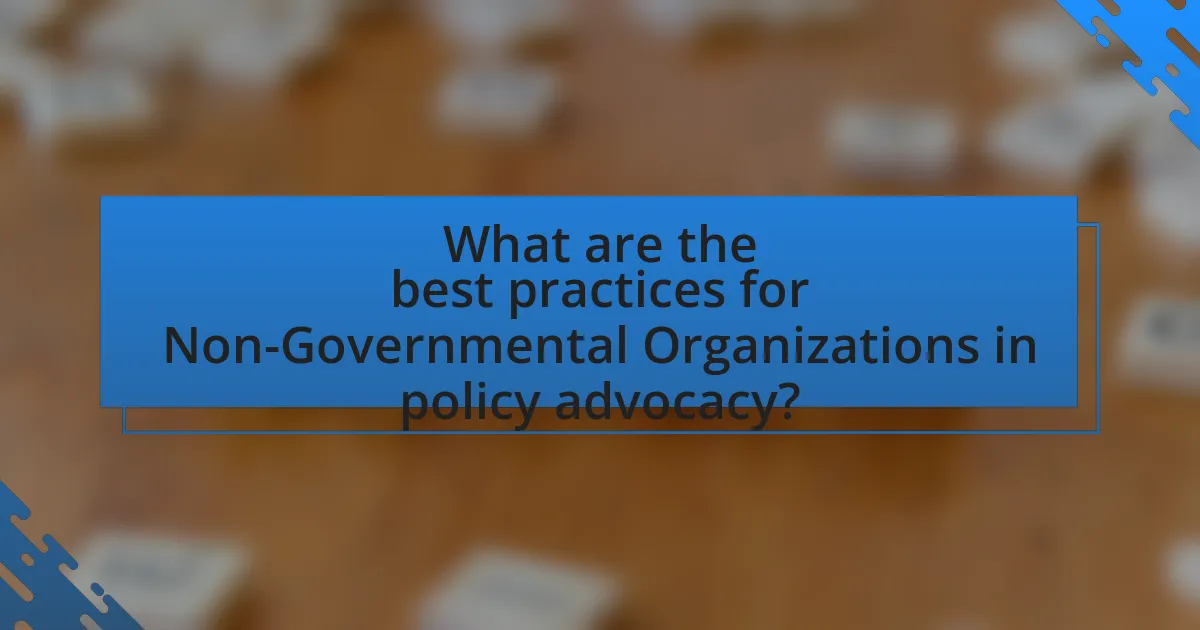
What are the best practices for Non-Governmental Organizations in policy advocacy?
The best practices for Non-Governmental Organizations (NGOs) in policy advocacy include building strong coalitions, engaging in evidence-based research, and maintaining transparent communication. Strong coalitions enhance collective influence, as seen in the success of the Global Fund to Fight AIDS, Tuberculosis and Malaria, which unites various stakeholders to advocate for health policies. Evidence-based research supports advocacy efforts by providing credible data, exemplified by the World Wildlife Fund’s use of scientific studies to influence environmental legislation. Transparent communication fosters trust and credibility, which are essential for effective advocacy, as demonstrated by organizations like Amnesty International that regularly update stakeholders on their campaigns and outcomes.
How can Non-Governmental Organizations effectively communicate their messages?
Non-Governmental Organizations (NGOs) can effectively communicate their messages by utilizing clear, concise language and targeted messaging strategies. This involves understanding their audience and tailoring communication to resonate with specific demographics, which enhances engagement and comprehension. For instance, NGOs can leverage social media platforms to disseminate information rapidly and interactively, reaching a broader audience. According to a 2020 report by the Global NGO Technology Report, 70% of NGOs reported that social media was their most effective communication tool, highlighting its importance in modern advocacy. Additionally, employing storytelling techniques can create emotional connections, making the messages more relatable and impactful. By combining these strategies, NGOs can ensure their messages are not only heard but also understood and acted upon.
What communication tools are most effective for advocacy campaigns?
The most effective communication tools for advocacy campaigns include social media platforms, email newsletters, and public relations strategies. Social media platforms, such as Facebook and Twitter, enable organizations to reach a broad audience quickly and engage with supporters in real-time, which is crucial for mobilizing grassroots support. Email newsletters allow for direct communication with supporters, providing updates and calls to action that can drive engagement and participation. Public relations strategies, including press releases and media outreach, help to shape public perception and garner media coverage, amplifying the campaign’s message. Research indicates that campaigns utilizing a combination of these tools can increase their visibility and impact, as evidenced by the success of various advocacy initiatives that effectively leveraged these channels to influence policy change.
How can storytelling enhance the impact of advocacy efforts?
Storytelling enhances the impact of advocacy efforts by creating emotional connections that resonate with audiences, making complex issues more relatable and memorable. Research indicates that narratives can increase engagement and empathy, leading to greater support for advocacy initiatives. For example, a study published in the journal “Science” found that stories can significantly influence people’s attitudes and behaviors, as they allow individuals to see issues from different perspectives and foster a sense of urgency. By effectively utilizing storytelling, advocacy organizations can mobilize communities, influence policymakers, and drive social change more effectively.
What strategies can Non-Governmental Organizations employ to measure their advocacy impact?
Non-Governmental Organizations can employ several strategies to measure their advocacy impact, including the use of outcome mapping, surveys, and policy analysis. Outcome mapping allows organizations to track changes in behavior, relationships, and actions resulting from their advocacy efforts, providing a clear framework for assessing progress. Surveys can gather quantitative and qualitative data from stakeholders, enabling NGOs to evaluate perceptions and changes in awareness or attitudes related to their advocacy. Policy analysis involves examining changes in legislation or policy outcomes that can be directly linked to advocacy efforts, offering concrete evidence of impact. These strategies collectively provide a comprehensive approach to measuring advocacy effectiveness, supported by empirical data and stakeholder feedback.
What metrics are useful for assessing the success of advocacy initiatives?
Metrics useful for assessing the success of advocacy initiatives include policy changes, public awareness levels, stakeholder engagement, and funding increases. Policy changes indicate the direct impact of advocacy efforts, as successful initiatives often lead to new legislation or amendments. Public awareness levels can be measured through surveys or media coverage, reflecting how well the advocacy message has reached the target audience. Stakeholder engagement metrics, such as the number of partnerships formed or participation in events, demonstrate the initiative’s ability to mobilize support. Additionally, increases in funding can signify the initiative’s credibility and effectiveness, as financial backing often correlates with perceived success in advocacy efforts.
How can feedback loops improve future advocacy efforts?
Feedback loops can enhance future advocacy efforts by facilitating continuous learning and adaptation based on stakeholder responses. By systematically collecting and analyzing feedback from target audiences, advocacy organizations can identify what strategies are effective and which areas require improvement. For instance, a study by the Stanford Social Innovation Review highlights that organizations utilizing feedback mechanisms saw a 30% increase in campaign effectiveness due to better alignment with community needs. This iterative process allows NGOs to refine their messaging, adjust tactics, and ultimately increase their impact on policy change.
What are the common pitfalls Non-Governmental Organizations should avoid in policy advocacy?
Non-Governmental Organizations (NGOs) should avoid several common pitfalls in policy advocacy, including lack of clear objectives, insufficient stakeholder engagement, and failure to adapt to changing political contexts. Clear objectives are essential for guiding advocacy efforts; without them, NGOs risk diluting their message and impact. Insufficient engagement with stakeholders, including affected communities and policymakers, can lead to advocacy that does not reflect the needs or realities of those it aims to serve. Additionally, failure to adapt to changing political contexts can result in outdated strategies that do not resonate with current decision-makers or public sentiment. These pitfalls can undermine the effectiveness of advocacy efforts and hinder the achievement of policy goals.
How can Non-Governmental Organizations ensure they remain relevant in changing political landscapes?
Non-Governmental Organizations (NGOs) can ensure they remain relevant in changing political landscapes by actively engaging in adaptive strategies that align their missions with current socio-political dynamics. This includes conducting regular assessments of the political environment to identify emerging issues and opportunities, thereby allowing NGOs to pivot their focus and advocacy efforts accordingly. For instance, NGOs that have successfully adapted to shifts in political climates often utilize data-driven approaches to inform their strategies, ensuring their initiatives resonate with both the public and policymakers.
Moreover, fostering partnerships with other organizations, including grassroots movements and local communities, enhances their influence and reach. A study by the International Journal of Nonprofit and Voluntary Sector Marketing highlights that NGOs that collaborate effectively can amplify their voices and create more significant impacts in policy advocacy. By maintaining transparency and accountability, NGOs can build trust with stakeholders, which is crucial for sustaining relevance in fluctuating political contexts.
What ethical considerations should guide the advocacy efforts of Non-Governmental Organizations?
Ethical considerations guiding the advocacy efforts of Non-Governmental Organizations (NGOs) include transparency, accountability, respect for human rights, and cultural sensitivity. Transparency ensures that NGOs disclose their funding sources and decision-making processes, fostering trust among stakeholders. Accountability involves being answerable to both the communities served and the donors, ensuring that actions align with stated missions. Respect for human rights mandates that NGOs advocate for the dignity and rights of individuals, avoiding actions that could harm vulnerable populations. Cultural sensitivity requires NGOs to understand and respect local customs and values, ensuring that advocacy efforts do not impose external beliefs or practices. These ethical principles are essential for maintaining credibility and effectiveness in policy advocacy.
What practical tips can Non-Governmental Organizations follow for successful policy advocacy?
Non-Governmental Organizations (NGOs) can enhance their policy advocacy efforts by employing several practical strategies. First, NGOs should conduct thorough research to understand the policy landscape, which includes identifying key stakeholders, understanding existing policies, and analyzing data relevant to their advocacy goals. For instance, a study by the World Bank highlights that evidence-based advocacy significantly increases the likelihood of influencing policy decisions.
Second, NGOs must build coalitions with other organizations and stakeholders to amplify their voice and resources. Collaborative efforts can lead to a more unified approach, as demonstrated by the successful coalition of environmental NGOs that influenced climate policy in various countries.
Third, effective communication is crucial; NGOs should craft clear, compelling messages that resonate with both policymakers and the public. Research from the Pew Research Center indicates that well-structured messaging can enhance public engagement and support for policy initiatives.
Lastly, NGOs should engage in continuous monitoring and evaluation of their advocacy efforts to assess impact and adapt strategies as needed. The Center for American Progress emphasizes that adaptive learning in advocacy leads to more effective outcomes over time.
